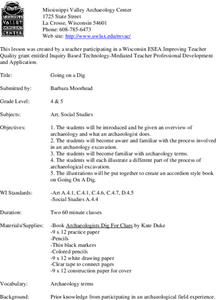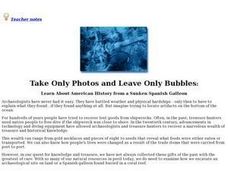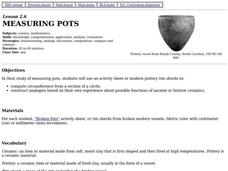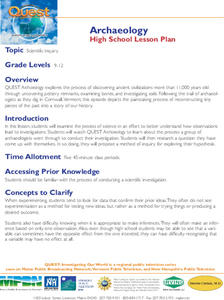Curated OER
Life in Ancient Mesopotamia
Students reconstruct and make drawings of vessels in the same manner as an archaeologist. In this archaeologist lesson plan, students each get a piece of a broken pot and they have to work together to put it back together. Once it is...
Curated OER
Archaeologists Reveal King Tut's Mummy
Learners look at pictures of a sarcophagus, then read a news article about King Tut's mummy. In this current events lesson, the teacher introduces the article with a discussion, pictures, and a vocabulary activity, then students read the...
Curated OER
Archaeology
In this archaeology worksheet, students answer 8 questions about archaeology. For example, "How are most archaeological sites discovered?"
National First Ladies' Library
Digging up the Past: Sir Arthur Evans and the Palace at Knossos
Middle schoolers explore the excavations of the Palace of Knossos on the Island of Crete. They create a simulated news broadcasting on the work of Sir Arthur Evans and his colleges. In their news investigation, learners cover such topics...
Curated OER
Shoebox Dig
Students participate in a simulation in which they dig for artifacts in a shoebox filled with objects. In groups, they record the types of material and artifacts found in each layer. To end the lesson, they answer questions on the...
Curated OER
Exploring Archaeology and Trade in the Middle School Latin Class
Students in a Latin class focus on archeology and trade from the Hellenistic period through the Middle Ages. In groups, they read various stages of a primary source documents in which they discuss and answer questions. To end the...
Curated OER
Basics of Archaeology
Middle schoolers identify what and how to complete an Archaeological excavation is conducted. They identify the transition from one layer to the next more easily if the colors of the layers are different. When creating a dig, the...
Curated OER
Protecting the Past: Give a Hoot, Don't Loot!
Students, in small groups, simulate an ancient civilization and the art they created, another group represents vandals, and the final group represents archaeologists who try to figure out what life was like for the "ancient peoples". ...
Curated OER
Contextual Clues
Learners observe and interpret images of artifacts in different contexts in order to recognize importance of leaving artifacts in original context to correctly understand their meaning, and observe what is surrounding object to interpret...
Curated OER
Going on a Dig
Students study an overview of archaeology and what an archaeologist does. They examine the process involved in an archaeology excavation and illustrate a different part of the process of archaeological excavation.
Curated OER
Stone Tool Scavenger Hunt
Seventh graders use Internet to familiarize themselves with variety of stone tools used by early man, create information chart describing each tool and its purpose, and discuss why tools have survived thousands of years.
Curated OER
Dr. Dirt's Archaeology Lab Artifact Analysis
Students simulate analyzing artifacts in archaeological lab by using real techniques that archaeologists use. Students practice measuring skills, drawing, writing, and brainstorming, and make inferences based on evidence.
Curated OER
Mapping and Excavating a Jello Mold
Learners simulate how archaeologists excavate sites by "searching" their own site in the form of a Jello mold. They use a grid to map the objects in the Jello mold as well as looking at three layers of Jello to understand stratigraphy...
Curated OER
A Matter of Life and Death
Students research burial tombs of ancient Egypt and Acting as pharaohs of Egypt, students create burial plans to illustrate what items they would include in their own tombs and why. They then act as archaeologists and analyze other...
Curated OER
Can You Dig It?
Students use a mock archaeological site to dig up artifacts. They read an article about artifacts found in Syria. They develop a list of artifacts that are related to specific sites in the community. They create an exhibition of these...
Curated OER
Ancient Civilizations
Sixth graders, in groups, research the culture of an ancient civilization. They use the Internet to locate artifacts that illustrate different elements of culture, write a description and analysis of each piece and present their work to...
Curated OER
Back From the Future
Students pose as archaeologists, famous for their scholarly excavations, writing, and lectures about ancient cultures and are invited back to the 20thy century from the year 3000 to explore an archaeological sit, their classroom.
Curated OER
Take Only Photos and Leave Only Bubbles: Learn About American History from a Sunken Spanish Galleon
Students simulate the research process of investigating a shipwreck. In small groups, they conduct Internet research, and develop and write a proposal for excavation of the archaeological site.
Curated OER
Mycenaean Trade in the Mediterranean
Students role play as scientists working for the Institute of Nautical Archaeology, Bodrum, Turkey. They locate Bodrum on a map and study the Mycenaean trade around the Mediterranean Sea. They discover what goods were traded during the...
Curated OER
Pottery Traditions
Students make and decorate a replica of a North Carolina coiled pot after summarizing why archaeologists study pottery and how Indian people of North Carolina made and used coiled pottery.
Curated OER
Measuring Pots
Students use an activity sheet to construct analogies about possible function of ancient or historic ceramics and compute circumference from a section of a circle as they study measuring pots.
Curated OER
Archaeology Preservation Lab
Students imagine themselves excavating their classroom 5000 years in the future. They discuss what they find there, what items be preserved and which not, and what the objects tell about the people who lived there.
Curated OER
Archaeology
High schoolers examine how observations lead to investigations, and how archaeologists conduct their investigation.
Curated OER
Archaeology
Students compare and contrast the role of scientists with that of archaeologists. They also describe the roles of observations and evidence in science.

























